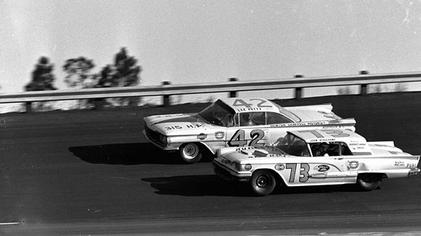This goes a ways back but there may be a few on our site that haven't seen this photo.But it changed the course in history for some. Do you remember this wreck?

updated by @johnny-mallonee: 12/05/16 04:00:58PM
This goes a ways back but there may be a few on our site that haven't seen this photo.But it changed the course in history for some. Do you remember this wreck?

Wood it be Daytona FL ?
could it be the Rebel 400 in Darlington in 1970????
And for members who joined throughout the year, Tim Leeming posted about the 1961 Daytona 500 here;
http://stockcar.racersreunion.com/forum/topics/racing-history-minute-1961-daytona-500
Lee Petty was seriously hurt in one of the 1961 DAYTONA qualifying races.
NOTE: ON RIGHT SIDE OF ABOVE PHOTO IS THE RICHARD PETTY'S LEFT REAR FENDER OF HIS WRECKED #43 IN THE OTHER 1961 DAYTONA qualifying race.

Thanks for any information or photos posted.
Dennis Garrett
Richmond,Va.USA
Miraculous Lee survived, but this crash ended his career. Looking closely, the bone-stock front seat isstillvisible. The passenger back-rest was removed for racing purposes. A single lap-belt was likely on-board, too. Equally scary is Daytona's single strand. wooden-post-supported, guard rail. We've come a loooonnnnng way.
Bobby,did you notice the roll bars in both the cars? Lees car doesnt appear to have a upright or even a loop in the drivers area and Johnnys car sure collapsed on the front left corner like nothing was there for support. If there was a support they surely left the scene . As you said we have come a long way in the safety dept.
Here is a set of spec roll bars for 1964 wow and I used to drive with these protecting me too

Johnny, coincidentally, I've been studying the Petty/Beauchamp crash lately. I've 'zoomed in' as much as I could on Beauchamp's #73, and the only apparent roll cage is a single hoop behind the driver. There does not appear to be anythingsupporting the A-post area. Watch the you-tube videos of this crash...one in particular, shows Beauchamp landing in the parking lot. He was very lucky too...only 'minor head injuries'.
And on another note on Lee Petty and Johnny Beauchamp here is another photo of the same two doing battle in almost the same spot but in 1959 with Beauchamp on the inside and Petty on the outside just as they were in 1961. Only this was called a photo finish. How ironic that the two would be in this same position more than once only to have the second encounter go bad.

 The #42 of Lee Petty sits in the garage area after an encounter with Johnny Beauchamp in the 4th turn in one of the qualifying races for the 1961 Daytona 500. Its interesting to note that most Grand National cars used bench seats with the back removed during this time period. This is a Chuck Little photo from the Marty Little collection.
The #42 of Lee Petty sits in the garage area after an encounter with Johnny Beauchamp in the 4th turn in one of the qualifying races for the 1961 Daytona 500. Its interesting to note that most Grand National cars used bench seats with the back removed during this time period. This is a Chuck Little photo from the Marty Little collection.
 The #42 of Lee Petty sits in the garage area after an encounter with Johnny Beauchamp in the 4th turn in one of the qualifying races for the 1961 Daytona 500. Its interesting to note that most Grand National cars used bench seats with the back removed during this time period. This is a Chuck Little photo from the Marty Little collection.
The #42 of Lee Petty sits in the garage area after an encounter with Johnny Beauchamp in the 4th turn in one of the qualifying races for the 1961 Daytona 500. Its interesting to note that most Grand National cars used bench seats with the back removed during this time period. This is a Chuck Little photo from the Marty Little collection.
Guess France didn't make enough profit from the first two years of operating DIS to be able to afford a concrete wall all the way around the track..
If I remember correctly, the 1970 Superbird in the Petty museum had a (flat) bucket seat from a Dodge van. It took a long time for stock seats to disappear from stock cars.
Given the safety of the cars at that time, there's a decent chance that concrete walls would have been more dangerous than the wooden posts. Although not for this particular incident. Look at the demand for SAFER barriers. Once again my memory fails me, but I think that through the 70s, many tracks used armco barriers instead of concrete anywhere there weren't grandstands.
And some of them had no barriers at all.  Still, you'd think a high banked turn with a drop on the other side would have had concrete atleast. Just seems so weird. Then again, the Germans thought it was no big deal either when they came up with Avus. I wouldn't have parked there, lest a race car landed on it..
Still, you'd think a high banked turn with a drop on the other side would have had concrete atleast. Just seems so weird. Then again, the Germans thought it was no big deal either when they came up with Avus. I wouldn't have parked there, lest a race car landed on it..
In an effort to make AVUS the world's fastest race track, the north curve (known as "Nordkurve") was turned into a steep banking (43) made of bricks. In 1954, this shorter track hosted a non-championship Formula One race which was mainly a show by the Mercedes-Benz team, as no serious competition was present. In 1959, AVUS hosted its only World Championship F1 race, the 1959 German Grand Prix, won by Tony Brooks. This race weekend also saw the death of Jean Behra, as his Porsche flew over the top of the north turn banking, as there was no wall or fence. German driver and journalist Richard von Frankenberg had previously walked away from a similar spectacular crash.
This banking, which was considered dangerous by international racing standards, was dismantled in 1967 to give way to an expanded intersection under the Funkturm tower. From the top of this tower, one can see that the AVUS is not perfectly straight. Racing was continued with a flat north turn, but AVUS only held national touring cars DTM and Formula 3 events.